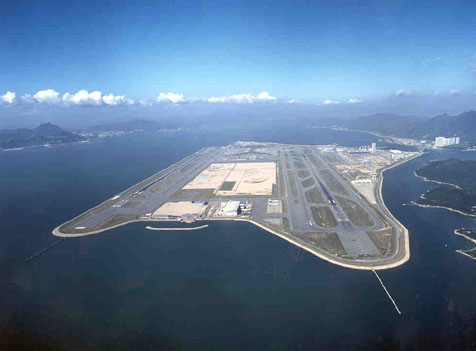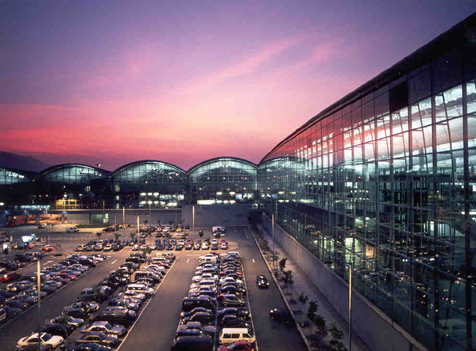Hong Kong International Airport
Hong Kong International Airport (HKIA) is one of the world's finest airports, moving passengers and cargo efficiently and placing Hong Kong at the forefront of Asia's aviation expansion.
A blank sheet of paper presented planners with the opportunity to create an airport that is functional, practical, and beautiful. From building the foundation of the airport platform form the sea bed up, to determining the highest standards of service and convenience for passengers, the result is world-class in every aspect.
Continuing a Tradition of Excellence
HKIA surpassed many of the high standards set by its predecessor and is even more user-friendly.
It took 73 years for Hong Kong's former airport at Kai Tak to evolve into one of the world's busiest airports and to be acclaimed as one of the great airports of the world. By 1997, passenger traffic had risen to 29.7 million a year and the airport was handling up to 31 takeoffs and landings an hour at its peak.
In comparison, HKIA operates 24 hours a day and currently can handle 49 aircraft movements per hour. This will increase gradually in the future. There are two all-weather runways and the airport has the capability to deal eventually with some 87 million passengers a year.
Kai Tak's problem was further compounded by a midnight-to-dawn curfew on landings and takeoffs as it was located in the middle of a populous residential and commercial district.
Despite continuous upgrading and modernization, it became apparent that Hong Kong needed a brand new airport, ideally, situated at some distance from built-up areas and served by a fast, efficient, public transport system.
In land-starved Hong Kong, finding such a site proved to be impossible and the solution therefore, was to reclaim two small islands 25 kilometers west to Hong Kong island, namely Chek Lap Kok and Lam Chau, to serve as the base for the new airport's 1255-hectre platform with work commenced in 1992.
Flying into the future
HKIA is one of the most spectacular airport complexes in the world. Grouped on the 1,255 hectare site are the impressive passenger terminal and its adjacent GTC; an international standard hotel; extensive facilities engaged in airport support, aircraft servicing, maintenance, air cargo, airline offices, various government departments and other organizations, all working together to achieve the highest levels of efficiency and service.
This impressive accomplishment was the result of precise planning, international teamwork, inter-company co-operation and foresight. Phase 1 and 2 of the airport were completed on time, and within budget, testifying to the drive, initiative and commitment of all involved.
The airport is a planned development that will continue to evolve and grow. With the opening of the second runway in May 1999 and the passenger terminal's Northwest Concourse in January 2000, the airport's passenger capacity increased from 35 million to 45 million a year.
Future plans include extensive commercial developments, and airport staff related amenities. Currently the airport provides employment for some 45,000 people with thousands more jobs downstream.
Passenger Terminal
Under the direction of the Airport Authority, the designers conceived of a passenger terminal that is a visually exciting introduction to Hong Kong and southern China. A building of vast proportions and internal spaces, it seems to float upon the landscape. The terminal captures the very essence of space, light and air and consolidates Hong Kong's positions as the region's most important center of aviation.
Despite its vast size, the terminal is surprisingly easy to negotiate. Travellers's needs were carefully considered during every design stage. The flow chart for departures and arrivals has been precisely drawn so that all procedures are convenient and pleasurable. For instance, where level changes were unavoidable, ramps, lifts and escalators are provided. Signage is prominent, precise and incorporates icons wherever possible to aid communication. Routes are clearly signposted from ground transport to departures gates and vice versa for arrivals.
Over 3.5 km of moving walkways, or travelators, are strategically placed inside the terminal building cutting walking time. An Automated People Mover, a driverless electric train located at basement level, travels the length of the 750-metre Central Concourse between its two ends in about 70 seconds. Check-in procedures also emphasise speed and efficiency. There are a total of nine check-in islands with 288 desks in the Departures Hall.
Amenities and Services
The passenger terminal is a destination in itself. Public and passenger areas alike have many amenities and services provided by Hong Kong SkyMart, a world-class retail and catering center. There is a wide variety of places to dine and the range of cuisine embraces practically every menu.
There are over 150 retail outlets offering duty-free liquor and tobacco; perfumes and cosmetics; general merchandise, local and international quality branded fashion and other specialty items. Free trolleys are provided in the Restricted Area for hand baggage and shopping.
In the Restricted Area, a novel Cyber Zone combines entertainment and retailing with free internet access, while the multimedia lounges are installed with additional workstations that provide up-to-the minute worlds news reports and financial data. A wireless service for personal laptops equipped with LAN is available. Also, two children's play areas sponsored by Cathay Pacific Airways Limited, keep tiny travellers amused. Passengers will find their respective routes through the terminal straight-forward. Transit passengers are accommodated in four zones(E1, E2, W1, W2). Arriving and departing passengers do not have to change levels in order to reach Customs or Immigration.
Luggage retrieval is aided by an automated baggage handling system that is capable of processing 13,680 pieces an hour. Arriving passengers clear Immigration in about 10 minutes, collect their baggage and then proceed to the Meeters & Greeters Hall and Ground Transportation Centre.
Ground Transportation Centre
The Ground Transportation Centre (GTC) , adjacent to the passenger terminal, is the hub for road and rail links to urban Hong Kong. The centre covers an area of 55,000sqm and houses the Airport Station, the terminus for the high-speed Airport Express railway. The journey to or from downtown Hong Kong takes approximately 23 minutes. Porterage is provided at Airport Station and luggage check-in facilities are available at both Kowloon and Hong Kong Stations for outbound passengers.
Elsewhere in the GTC are clearly designated areas for tour coaches, hotel shuttle and public buses, limousines and taxis. From here the public car parks are easily accessible. There are four open-air car parks (car parks 1, 2, 3, 5) and one multi-storey car park (car park 4), offering parking on an hourly, daily or monthly basis. Please click here for more transport information to and from the airport.
Commercial Organisations
By starting with a clean sheet of paper, HKIA benefited from a clear advantage whendetermining which facilities would constitute a major international airport serving the 21st century. With aircraft manufacturers planning to develop even larger aircraft; air passenger profiles constantly changing and air cargo tonnages continuing to climb; and with airlines becoming more competitive, an airport is no longer just about aircraft.
HKIA is a major center for aeronautical engineering and aircraft maintenance. In fact it is one of the few places in the world that can undertake the conversion of a B747 from a passenger aircraft to a cargo freighter.
The airport is also a major player in airline catering boasting the world's largest flight kitchen capable of producing 80,000 meals a day. The airport's three catering companies have a combined capacity of 120,000 meals per day.
Air cargo is another important component. The airport's current annual cargo capacity is three million tonnes, which ultimately can increase to nine million tonnes per year.
The Airport Authority is one of Hong Kong's biggest commercial landlords and it has the lease to operate the airport until 2040. The airport is already bringing substantial economic benefits to the territory and will continue to be a major contributor to Hong Kong's prosperity.

Hong Kong International Airport has been named one of the Top 10 Construction Achievements of the 20th Century.

The setting sun transforms the passenger terminal's cladding into sheets of gold. During the day, the building is suffused with natural light.
Chek Lap Kok Hong Kong International Airport appears on the following banknote(s):
| |